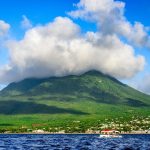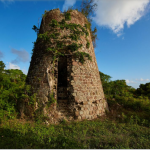Walk in the footsteps of Alexander Hamilton on this tiny Caribbean island
 By Susan B. Barnes From SMITHSONIAN.COM
By Susan B. Barnes From SMITHSONIAN.COM
The island of Nevis was no paradise for young Hamilton
As Hamilton continues its wildly popular run on Broadway and takes theaters across the country by storm on tour, we pull back the curtain on the stage sensation and take a closer look at the formative years of its namesake on the quiet Caribbean island of Nevis.
Alexander Hamilton was born on January 11, 1755 (or perhaps it was 1757—historical records vary, and even Hamilton himself was unsure of his precise birth year) on the small Caribbean island of Nevis, a body of land neighboring St. Kitts in the Lesser Antilles that was under British rule at the time and was known for its sugar plantations.
Hamilton lived on Nevis until he was about seven (or nine) years old, but despite the idyllic setting, his boyhood was not easy. Prior to his birth, his mother had fled an abusive marriage to an older man but paid a hefty price for her actions. According to Alexander Hamilton by Ron Chernow, “Enraged, his pride bruised, Lavien was determined to humiliate his unruly bride. Seizing on a Danish law that allowed a husband to jail his wife if she was found guilty of adultery and no longer resided with him, he had [Hamilton’s mother] Rachael clapped into dreaded Christiansvaren, the Christiansted fort, which did double duty as the town jail.”
Once freed, she moved to St. Kitts, where she met Scottish trader James Hamilton—Hamilton’s biological father. They relocated to the island of Nevis, but their relationship, too, soon failed. Alexander’s father left the family, and young Hamilton moved with his mother to St. Croix. When young Hamilton was around 11 years old, he took his first job, and shortly thereafter, his mother passed away, leaving Hamilton and his brother essentially orphaned. Despite adversity, Alexander proved to be a valuable and enterprising employee as a clerk in St. Croix, impressing his mercantile employer with his accounting skills to such an extent that he and other businessmen pooled their resources to send Hamilton away from the islands to further his education.
In 1773, when he was 16 or 18 years old, Hamilton left the Caribbean for America, where he attended King’s College (now Columbia University) in New York and began to forge his political career, serving in the Revolutionary War and as an advisor to George Washington himself. When Washington was elected president of the U.S. in 1789, he appointed Hamilton as the first Secretary of the Treasury in the United States. The rest, as they say, is history.
Back on Nevis, sugar plantations waned during this time, and the island’s main industry turned to tourism. But Hamilton’s legacy is alive and well. Beyond the draw of the island’s sparsely populated beaches, lush forests and generally laid-back vibe, visitors today can walk in Hamilton’s boyhood footsteps.
Hamilton’s Birthplace, Charleston
In the small capital city of Charlestown, visit the Museum of Nevis History, which sits on the site of Hamilton’s birthplace. The home as seen today is actually a replica of the original house, which was destroyed in a natural disaster and laid in ruins for some time. The house was reconstructed in 1983, and some say this was intended to commemorate Nevis’ independence. The museum has a small and informal exhibit that tells Hamilton’s story, both on the island and off, from his early years on Nevis to his military and political careers, even including his family life.
Ruins of the Hamilton Estate
In the hills that lead to Mount Nevis and Nevis Peak, the ruins of the Hamilton Estate—the family’s sugar plantation (though Alexander Hamilton himself never lived on the estate) that remained within the Hamilton family right up until the early-1950s—can still be seen. During its heyday, sugar operations included a windmill tower, boiling houses and a curing house.
As was a defining trait of the sugar industry worldwide, slave labor was relied upon at the Hamilton Estate. According to the Nevis Historical and Conservation Society, the Hamilton Estate was one of the last remaining intact sugar factories on the island until it closed in 1951. Today, passersby will find overgrown ruins of the windmill and an historical marker defining the site.
The Island at Large
Though not tied directly to Alexander Hamilton, several Charlestown sites are still in existence from the time in which he and his family were a part of the island’s legacy—including churches, the old customs house and, of course, the Charlestown port, to and from which ships sailed daily.
It may be difficult to imagine that such a pivotal figure in American history actually hailed from a petite island on which monkeys still outnumber people. But if anything, Alexander Hamilton’s Nevisian heritage, coupled with his many accomplishments on the mainland United States thereafter, only serves to prove that hard work really can pay off.
IMAGES:
Nevis Volcano A view of the Nevis volcano on the island of Nevis where Alexander Hamilton was born. (Sean Pavone)
A sign marks the spot of Hamilton’s birthplace on Nevis. (Susan B. Barnes)
The old mill on the Hamilton Estate. (Nevis Tourism Authority)
For more on this story go to: http://www.smithsonianmag.com/travel/alexander-hamilton-nevis-caribbean-island-180964047/#1pflzZBy6gvPYfE6.99







